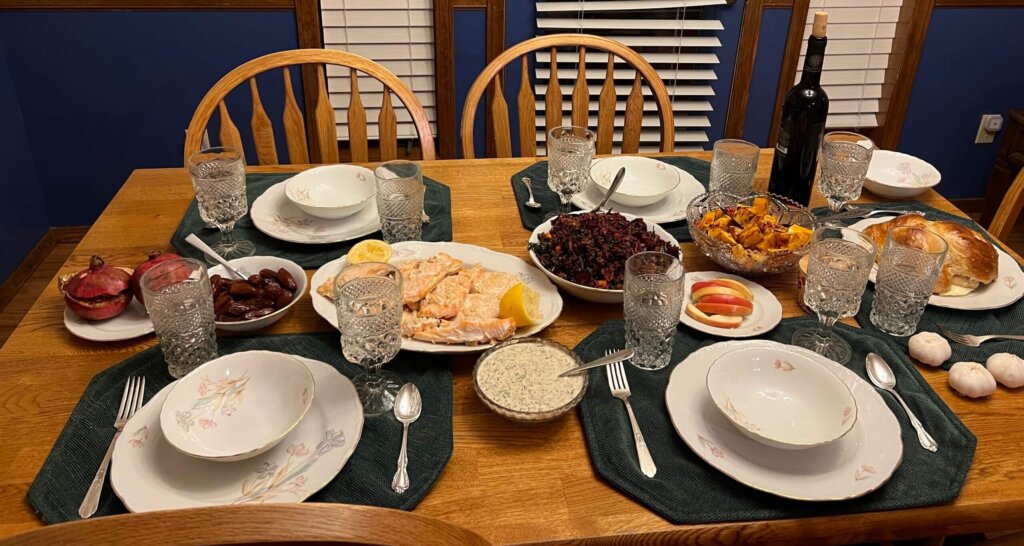We taste-tested affordable kosher wine for Rosh Hashanah
Our honest reviews and pairing advice for white, rosé and red kosher wines under $35

Graphic by Angelie Zaslavsky
“Why we don’t drink more bubbly for the Jewish New Year is a mystery to me.”
Jeff Morgan, who helped popularize rosé in the United States, is an expert winemaker. He also reminded us by email that even the heaviest Jewish holidays should be a time for levity.
“We treat them like they’re too heavy. They should be fun!” says Rob.
While standing in shul for hours might not feel joyous, a Rosh Hashanah dinner of delicious food and wine is a great way to festively ring in the new year.
Great wines can elevate the experience. But it can be difficult to know where to begin.
Many of the traditional Rosh Hashanah foods — brisket, pomegranates, apples and honey and sticky egg challah — are heavy and sweet. When choosing wines to accompany your dinner, you’ll want to look for bottles with enough acid and boldness to stand up to the richness of our holiday meals.
In that spirit, we tasted 11 bottles from around the world — whites, reds and a rosé — in the $20-35 price range that fit the bill. (Looking for kosher wines under $25? We’ve got you.) Some lived up to our hopes — and others fell flat. We share our honest reviews below.
Kosher White Wines
In general, white and rosé wines are best served chilled. Refrigerate your bottles for at least 2 hours, and take them out of the fridge 30 minutes before serving. White wines often work well with food in complementary pairings, so try matching the dominant and subtle flavors of your dishes to those of the wine. Most of these bottles are fairly acidic and will stand up nicely to heavy dishes and fruit-forward sauces.
$30
California
“Okay. My big tasting note is this is really delicious,” says Rob. Pinot Blanc is a mutation of the Pinot Noir grape, and this medium-bodied Northern California wine is full of fruity and apple flavors and is “totally drinkable.” Great for serving with your first course.
$35.49
France
Sancerre wines, made of Sauvignon Blanc grapes, are generally super dry and minerally. This bottle, however, is refreshing and straightforward: Highly acidic, very light colored, with intense notes of green apple.
$19.99
Israel
A ton of flavor in a light-bodied package: Kiwi, citrus and “overpowering” guava characterize this Israeli wine. “Kosher wines are really coming up in the world,” says Rob after tasting a glass. This fragrant and highly drinkable wine would go well with dates and other simanim.
$20.99
Greece
This wine from the Greek island of Samos, using Muscat grapes grown at high elevation, has such a deep richness to it. Almost syrupy in consistency, with deep notes of black currant and golden raisins, this white wine hits like a port on the nose. Notes of fig round out the body and the finish is silky smooth. Would go well with sweet and sour dishes, root vegetables, and any fruit-based sauces.
$19.99
Greece
This white wine is from the Greek island of Cyprus. This varietal is used to make a very popular dessert wine, but this bottle is dry, understated and super light-bodied, with notes of apricot, peach, and jasmine. Has a bit of a tang, with notes of hay and freshly cut grass, that would go well with goat cheese.
Kosher Rosé
California
$31.99
Winemaker Jeff Morgan (full disclosure: a friend of ours) helped popularize rosé in the United States, and you’ll understand why when you try this rosé. This wine is made from a blend of Grenache, Pinot Noir and Syrah. It is eminently drinkable, no matter which vintage you choose. It is lightly minerally and heavily acidic, with dominant notes of strawberries. “It would cut right through your mother’s fatty brisket,” says Rob. It’s a bit pricey for an everyday rosé, so save it for a special occasion.
Kosher Red Wines
Most reds will benefit from breathing a bit before serving. Introducing oxygen about 30 min before serving the wine will allow the tannins in the wine (the chemicals that cause your tongue to feel grippy, like rough velvet) to mellow out and fully develop. Most red wines are best served around 60°F. In a pinch, you can set your bottles in front of the A.C. for an hour or so. We won’t judge.
$27.99
New Zealand
Save your money — we didn’t love this one. “It’s kind of got a watered-down, pond flavor,” says Rob. “I wouldn’t buy it again.” Goose Bay does, however, make an excellent Sauvignon Blanc.
$29.99
Israel
This is a bold and juicy sleeper hit out of the Judean hills. Made with Cabernet Sauvignon, Petit Verdot and Malbec, “Summer” is deeply fruity and delicious. First thing you taste is raspberry jam, and the complexity of flavor of a good summer berry. You can really smell the minerality on the nose, but the mouth is all berry. Light notes of menthol, mulberry and “asphalt in a good way.”
Herzog Variation Five Cabernet Sauvignon 2021
California
$24.99
This wine is certified organic and sulfate free. It has a deep raspberry and blackberry flavor, with an earthiness that adds depth and complexity. The nose has a beautiful smell that “just fills your mouth,” and “it just makes you want to keep drinking it.”
$24.99
It’s nearly impossible to find a drinkable kosher Bordeaux blend under $30. Unfortunately, this one does not fit the bill. The flavor is quickly overwhelmed by overdeveloped tannins that only get worse. Even after letting it breathe for an hour, I had to force myself to finish the glass.
A better option? This $14 bottle from Chateau les Riganes.
Israel
$27.99
Jacob Ner-David (full disclosure: a friend of Laura’s) consistently produces some of the most interesting and nuanced Israeli wines, and Jezreel’s Nahalal is no exception. “This is a serious red wine,” says Rob, remarking on the deep cherry and dark fruit notes. “It’s really rewarding.” Aging the wine in mostly used French oak barrels results in very soft tannins, lending depth without overwhelming the palate. This wine is a blend of 50% Shiraz and 40% Carignan, and would pair well with almost anything.
General tips for pairing kosher wine and food
Rules are meant to be broken. But understanding some basics first helps you do so in style.
- Lead with the food. Think about your menu’s dominant and subtle flavors, including the spices and seasonings you will be using, and let them shine by picking wines that either complement or contrast them. White and rosé wines generally lend themselves more naturally to complementary pairings, while reds work well for contrast pairings.
- Mind the sauce. What you will dress your dish with is a better guide to pairing than the protein or carb underneath it.
- Salty and fatty foods require a heavier wine. You want big bold flavors in the bottle to stand up to those on your plate. Highly tannic wines especially shine here.
- Bitter foods don’t play well with bitter wines. They will accentuate each other, and not in the ways that you want.
- Your wines should be more acidic and sweeter than your food. A lemon chicken dish needs a bright and bracing white wine. A dessert dish likewise requires a wine that is either sweet and/or effervescent.
- Drink and eat what you like! More than any “rule,” this will keep you and your guests happy all holiday long.
Need some Rosh Hashanah Dinner inspiration?
Try Rob’s vegan brisket, Moroccan fish tagine and carrot salad, or beef tagine with quinces. Our columnist DenBerg illusrated some not-so-traditional Rosh Hashanah recipes. And our Yiddish editor has tips for making a not-at-all dry honey cake.
Laura’s Simple Pescatarian Rosh Hashanah Dinner

This is a low-fuss pescatarian Rosh Hashanah dinner menu featuring all of the simanim. I created it last year when I was celebrating at home with my family in the Ozarks, far from any high-quality kosher meat. For minimal culinary stress, celebrate the next morning by enjoying your coffee with Dini Klein’s Dang Good Breakfast Loaf.
Dinner:
Challah (use your favorite recipe, or store bought)
Apples and Honey
First Course: Leek Soup
Main Course: Honey Sesame Salmon
Wild Rice with Carrots and Beets
Roasted butternut squash — drizzle with silan (date honey) and pomegranate seeds
Did you miss the live event? Watch our Rosh Hashanah kosher wine taste test here:
Many thanks to our friend Jeff Morgan of Covenant Winery for his wisdom and recommendations.


















